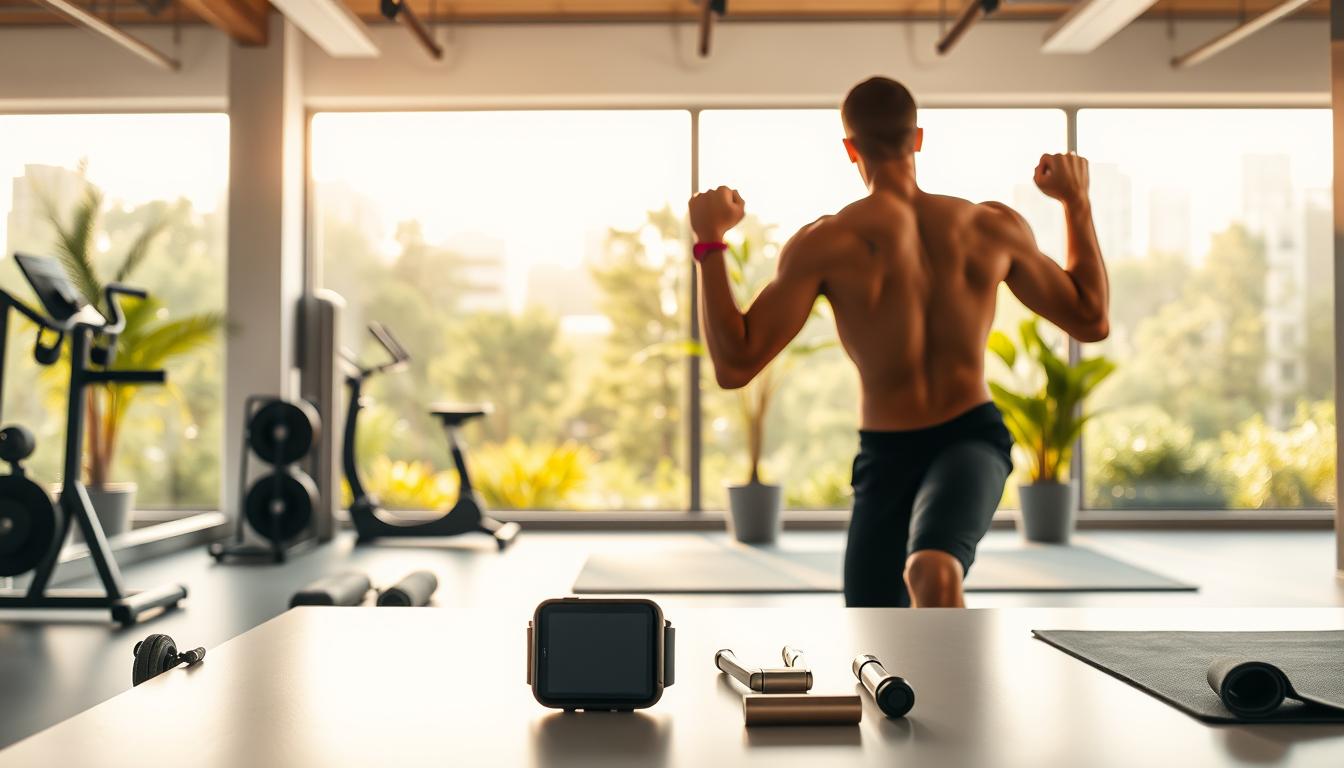Getting fit and healthy doesn’t mean extreme diets or endless gym time. This guide shares easy tips for better well-being without changing your life too much. Whether you’re new to fitness or already active, these hacks offer simple steps for busy lives. Discover how making small changes, like meal prep or quick workouts at home, can lead to big health gains.
Key Takeaways
- Small, consistent actions create meaningful fitness and health progress.
- Effective strategies work with your schedule, not against it.
- Science-backed methods simplify building healthy habits.
- Access to tools like home equipment and apps removes common barriers.
- Long-term success comes from blending exercise, nutrition, and recovery.
Understanding Fitness: More Than Just Exercise
True fitness is more than just going to the gym. It’s about how your body works and your lifestyle choices. Here’s how to create a balanced fitness plan:
The Five Components of Physical Fitness
- Cardiovascular Endurance: Activities like running or swimming boost heart and lung health.
- Muscular Strength: Lifting weights or doing push-ups builds muscle power.
- Muscular Endurance: Repetitive movements like cycling improve stamina.
- Flexibility: Stretching routines like yoga enhance joint mobility.
- Body Composition: Balancing fat and muscle mass supports overall wellness.
Setting Realistic Fitness Goals
Use SMART goals to stay on track:
- Specific: “Run 3 miles weekly” instead of “Get in shape.”
- Measurable: Track progress with a fitness app or journal.
- Attainable: Start small—like 15-minute walks daily.
- Relevant: Align goals with personal health priorities.
- Time-bound: Aim to complete a 5K in three months.
How Fitness Impacts Overall Health
| Component | Health Benefits |
|---|---|
| Cardio | Reduces heart disease risk |
| Muscle strength | Prevents age-related weakness |
| Flexibility | Improves posture and injury prevention |
| Body composition | Lowers diabetes risk |
Every component plays a role in better health. Prioritize all five for lasting results.
Quick Workout Hacks for Busy Schedules
Time constraints don’t have to stop you from staying fit. Even with a busy schedule, you can still fit in workout routines. Science backs up that 10–20 minute sessions of high-intensity interval training (HIIT) or Tabata can be as good as longer gym visits. Here’s how to make the most of your downtime:
- Micro-Workouts: Sneak in 5–7 minute exercise bursts. Try bodyweight squats during TV commercials or a wall sit while waiting in line.
- Tabata Efficiency: Four minutes of 20-second all-out effort followed by 10 seconds rest (e.g., burpees or jump squats) triggers post-exercise calorie burn.
- Lunch Break Routines: Use 30 minutes for a circuit: push-ups, lunges, and planks. Apps like Nike Training Club offer 15-minute guided sessions.
- Commute Hacks: Park far from the office entrance for extra walking, or do calf raises while brushing your teeth.
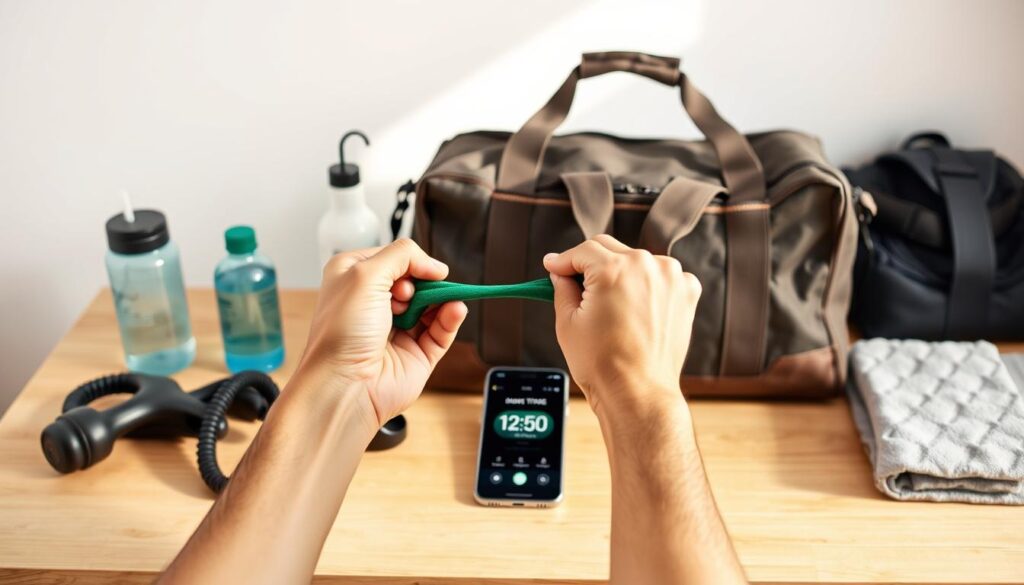
A 2023 study by the American Council on Exercise found that 3x weekly 15-minute HIIT sessions improved cardiovascular health as much as 40-minute steady-state cardio. Consistency is key, not how long you work out. Turn everyday moments into movement opportunities—like taking the stairs or dancing during virtual meetings. Your body adapts to what you do regularly, not what you perfect occasionally.
Nutrition Strategies to Fuel Your Fitness Journey
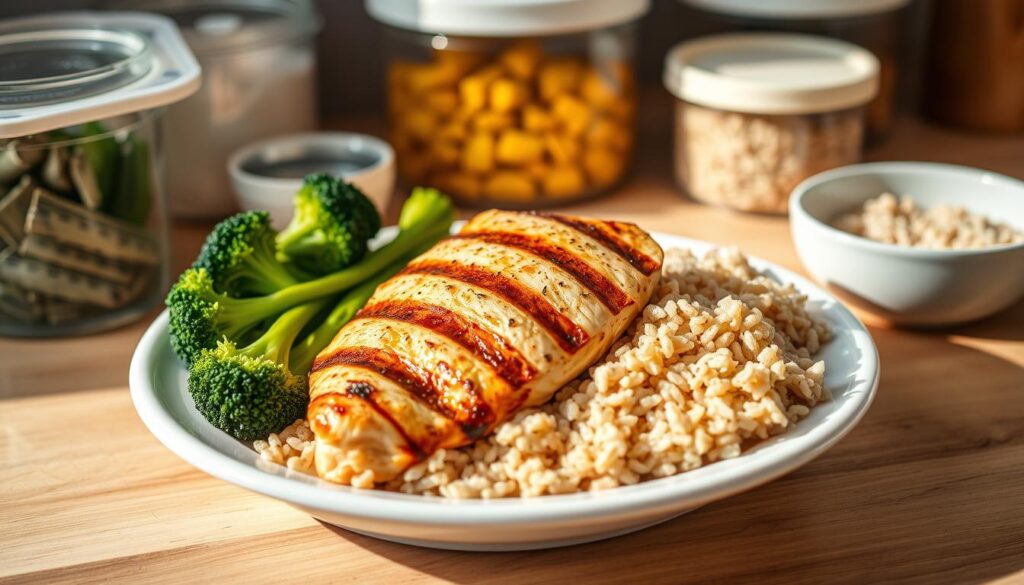
Getting the right nutrition is crucial for better workouts and more energy. Eating the right foods before, during, and after exercise helps your body perform and recover well.
Pre-Workout Nutrition Tips
Eat a mix of carbs and protein 1–3 hours before exercising:
- Whole-grain toast + peanut butter for sustained energy
- Low-fat Greek yogurt with berries for protein and antioxidants
- Avoid heavy fats or sugars that slow digestion
Post-Workout Recovery Foods
Replenish glycogen and repair muscles within 30–60 minutes post-exercise:
| Food Group | Examples |
|---|---|
| Protein | Salmon, turkey, whey protein |
| Carbohydrates | Quinoa, bananas, brown rice |
| Electrolytes | Coconut water, spinach, chia seeds |
Hydration Hacks for Optimal Performance
Track hydration with these strategies:
- Weigh yourself before and after workouts to measure sweat loss
- Use electrolyte tablets (e.g., Nuun Sport) for intense sessions
- Drink water infused with cucumber or lemon for flavor without added sugar
Meal Prep Strategies for Fitness Enthusiasts
Batch cooking saves time and ensures consistent nutrition:
“Meal prepping cuts decision fatigue and keeps you on track,” says registered dietitian Sarah Jones of NutritionFit.
- Divide containers into protein, carbs, and veggies (e.g., grilled chicken + sweet potato + broccoli)
- Use MyFitnessPal to track macros while meal prepping
- Freeze prepped meals for quick access during busy weeks
Home Gym Essentials: Equipment That Delivers Results
Creating a home gym doesn’t need a big budget or a lot of space. Choose versatile gear that fits your needs and space. Whether you have a small studio or a shared garage, these essentials can turn any area into a great place to work out.
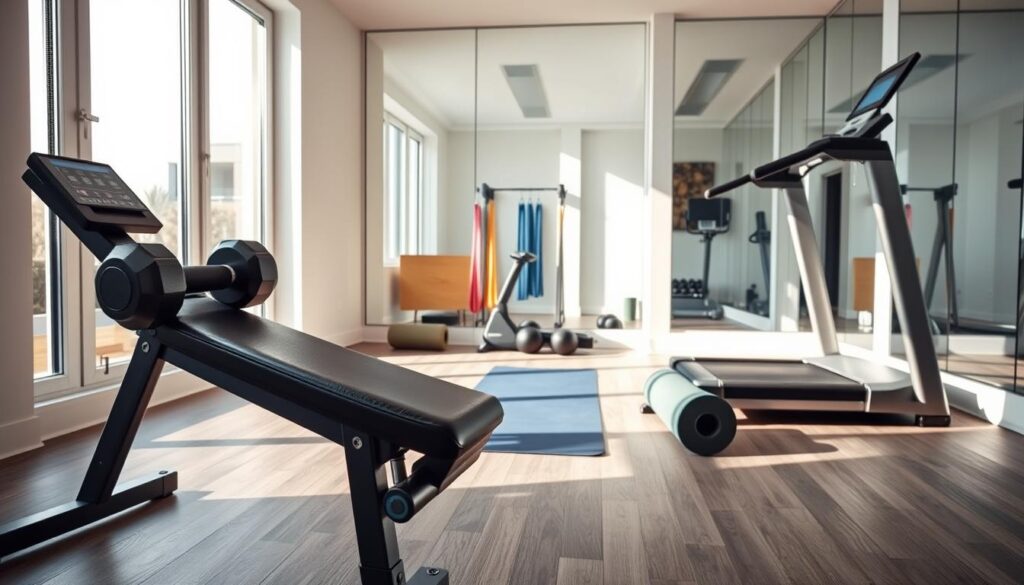
Budget-Friendly Fitness Equipment
Find great value with items under $150 that improve strength and flexibility:
- Resistance bands: $10–$50 sets for full-body workouts.
- Adjustable dumbbells: Brands like Bowflex offer 5–52.5lb options starting at $80.
- Kettlebells: Cast iron options from $30–$100 per bell.
Space-Saving Workout Tools
Choose multi-use gear that folds or mounts:
- Folding yoga mats or exercise mats for floor space flexibility.
- Wall-mounted pull-up bars (e.g., Iron Gym) that disappear when not in use.
- Compact adjustable benches like Aderia’s 10-in-1 design for compound movements.
Digital Fitness Resources
Apps and platforms turn your phone or tablet into a coach:
- Nike Training Club: Free workouts for all fitness levels.
- Peloton Digital for live and on-demand classes.
- MyFitnessPal for tracking progress alongside workouts.
Invest in items that grow with your fitness journey. Focus on durability over trends—quality kettlebells or bands last years. Combine physical gear with digital tools for guided routines. This way, every corner of your space helps you reach your fitness goals.
Training Smarter: Maximizing Workout Efficiency
Effective training isn’t about spending more time at the gym. It’s about making smarter choices. Small changes can make a big difference. Focus on the structure of your workout, not just the number of reps.
Start by adding more weight, resistance, or difficulty to your exercises. This challenges your muscles and helps them grow.
- Train with specificity: Match exercises to goals (e.g., squats for leg strength, planks for core stability).
- Optimize recovery: Rest days and sleep repair muscles, ensuring progress isn’t stalled.
- Use periodization: Rotate workout intensity and volume weekly to avoid plateaus.
“Quality over quantity. A well-designed exercise plan beats endless hours of random movements.”
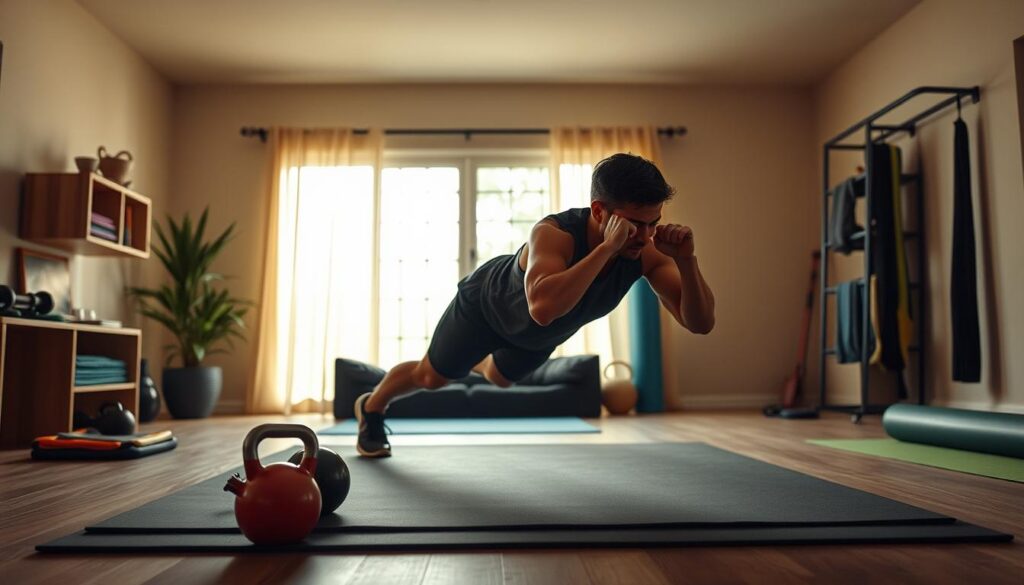
Plan your workouts based on your schedule. For example, alternate upper-body, lower-body, and full-body days. Keep track of your progress in a journal to spot trends.
Avoid common mistakes like skipping warm-ups or rushing through movements. Poor form can lead to injury and limit your gains. Adjust rest time (30-90 seconds between sets) or tempo (slower lifts build strength) to meet your goals.
Smart training makes every session count. Focus on consistency and precision, not just how hard you’re trying. Your body adapts when you challenge it in a smart way.
The Power of Recovery in Your Fitness Routine
Recovery isn’t just downtime. It’s the key to making progress. Your body fixes muscles and recharges energy when you rest. This boosts your exercise results and overall wellness. Make recovery a priority to see the best results from your workouts.
Sleep Quality and Exercise Performance
How you sleep affects your workouts. Deep sleep fixes tissues, and REM sleep sharpens your focus. Bad sleep slows down recovery. Here’s how to improve:
- Stick to a bedtime routine.
- Keep your room cool and dark.
- Limit screens before bed.

Active Recovery Techniques
Choose gentle movements for recovery. These help blood flow without overworking muscles. Try:
- 20-minute walks to clear out lactic acid.
- Yoga to boost flexibility.
- Using foam rollers for self-myofascial release.
Studies show these methods cut down on soreness and get you ready for tough exercise faster.
“Rest is the force that turns effort into strength.” – ACE Fitness
When to Take a Rest Day
Pay attention to your body. If you’re always tired, have joint pain, or feel burnt out, it’s time to rest. Look out for these signs:
- Muscle soreness that lasts more than 72 hours.
- Not being able to perform as well in workouts.
- Feeling emotionally drained from training.
Ignoring these signs can slow down your progress and increase injury risks.
Wellness Practices That Complement Your Workout Regimen
Improving wellness is more than just going to the gym. It’s about adding habits that make your workouts better and keep you healthy. Small daily actions can make a big difference, keeping your progress steady and fun.

Mindfulness and Fitness
Mindful exercises help you focus on your movements. Pay attention to how your body feels, like the stretch in yoga or the beat of your footsteps. Mindful breathing during workouts can also help you lift better and avoid injuries. Here are some tips:
- Start with 5 minutes of meditation before you work out
- Try yoga that focuses on breath and body alignment
- Use apps like Headspace for mindfulness exercises
Stress Management for Physical Performance
Too much stress can slow down muscle recovery and fat burning. Here’s how to fight it:
- Do 10-minute stretches every day to lower stress hormones
- Take short walking meditation breaks every 90 minutes
- Use heart rate monitors to track your stress levels (e.g., Fitbit Stress Management Tools)
“Stress reduction increases workout efficiency by up to 20%,” says Dr. Amy Baltzell, exercise physiology professor at Drexel University.
Creating Sustainable Healthy Habits
Behavioral science shows that habit stacking is effective. Link new habits to things you already do:
- Keep your workout clothes next to your bed (a reminder to exercise in the morning)
- Link drinking water to meal times (“drink a glass before each snack”)
- Use habit trackers like Daylio to track your progress
By following these tips, you can create habits that grow with you. This turns health goals into lasting practices.
How to Work With a Personal Trainer Effectively
Working with a personal trainer can really boost your fitness. But, it’s all about understanding each other. First, check their credentials. Look for certifications like NASM, ACE, or NSCA. These show they know a lot about keeping you safe and helping you perform better.
Before choosing a trainer, ask them three important questions:
- What methods do you use to track progress?
- How do you adapt training plans for clients with injuries or limitations?
- What’s your approach to balancing intensity and recovery?
Here’s a table to help you compare certifications:
| Certification | Focus | Example |
|---|---|---|
| NASM | Corrective exercise | Posture-focused workouts |
| ACE | Holistic wellness | Nutrition and stress management |
| NSCA | Strength training | Powerlifting programs |
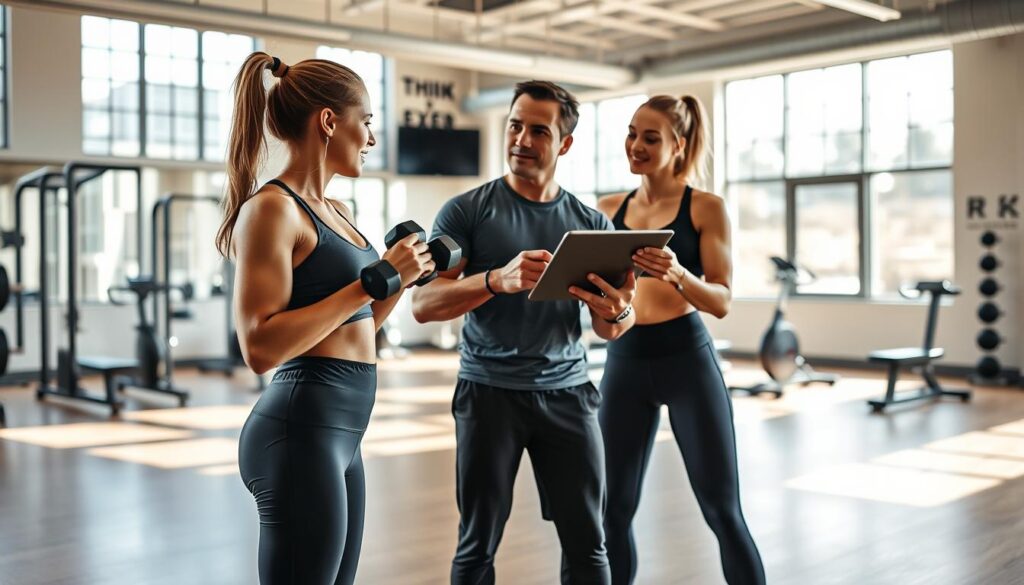
Talk about your goals and any health issues at the start. If you’re recovering from an injury, tell them right away. You should get updates every 4–6 weeks. Also, ask for a written plan that shows your fitness goals.
If money is tight, think about mixing personal sessions with workouts you do on your own. This can be a good way to save money.
“The best personal trainer partnerships are built on honesty and clear communication.” – ACE Fitness Journal
End each session by telling your trainer how you feel, on a scale of 1–10. If you’re not seeing results after three months, it might be time to look for a new trainer. Remember, both you and your trainer need to be active in your training to see real results.
Technology and Apps That Transform Your Fitness Experience
Modern fitness tech does more than just count steps. It uses smart devices and apps to turn data into useful insights. This makes workout routines more effective. Let’s see how tech can improve your training without being too much.
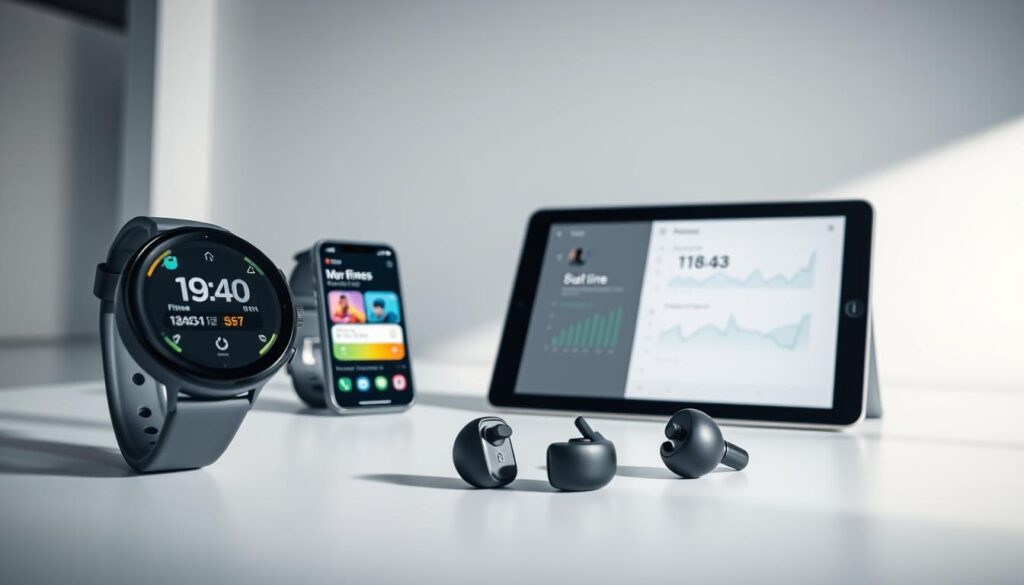
Fitness Trackers Worth the Investment
- Fitbit Sense 2: Tracks stress levels and skin temperature alongside heart rate zones.
- Apple Watch Ultra: Dive into swimming metrics and customizable workout laps.
- Garmin Vívomove 4: Hides tech behind watch faces while logging recovery time and sleep stages.
Workout Apps for Every Fitness Level
Apps like Nike Training Club offer free guided sessions for beginners. Pear Training uses GPS to help with run pacing. For form feedback, JEFIT’s AI checks weightlifting reps via smartphone cameras.
Virtual Training Platforms and Communities
Join live Zoom classes with Les Mills On Demand or follow Beachbody’s 21 Day Fix challenges. Studies show virtual communities help keep you consistent—
“Users with app-based accountability partners are 35% more likely to stick to routines,”
notes the Journal of Sports Science.
Choose tech that fits your goals. Stay away from gadgets that focus too much on games. Let devices guide your fitness journey, not control it.
Conclusion: Integrating Fitness Hacks Into Your Everyday Life
Health and wellness come from small, consistent choices. Start with one or two fitness changes that fit your daily life. Maybe it’s a 10-minute morning stretch or meal prep on Sunday.
These small actions add up over time. They boost your energy and physical ability.
Time constraints? Focus on smart habits. Use apps like MyFitnessPal to track meals or follow 15-minute YouTube workouts with resistance bands. Even short efforts can make a big difference.
Don’t let fatigue or busy days stop you. Plan workouts when you have the most energy, like waking up 15 minutes early for a walk. Pair your post-work meals with protein-rich snacks like Greek yogurt to help with recovery.
Small adjustments keep progress steady, not overwhelming.
Focus on making sustainable changes. Replace sitting with active choices: take the stairs, walk during calls, or try yoga videos at home. These small habits strengthen your fitness without taking up extra time.
Start today. Pick one strategy, like using a Fitbit to track steps or dedicating 30 minutes weekly to meal prep. Every change brings you closer to a healthier lifestyle. It improves how you feel and function every day. Consistency, not perfection, leads to long-term success.
